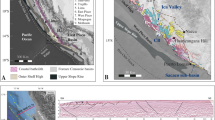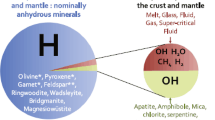Summary
With a view to obtaining preliminary base-line values in seawater and sediment from German coastal regions, a survey was undertaken in 1975, as a part of the Radiological North Sea Programme (RANOSP), to measure the activity levels of239+240Pu and137Cs; a limited number of241Am and238Pu measurements are also included. The results of this survey are presented.
Increased levels of activity can be discerned in seawater for137Cs in comparison to expected fallout values for this isotope. Although the increased activity of radio caesium in the North Sea is caused by waste discharge from nuclear fuel re-processing plants in the U.K. and France, transuranic isotope levels in the German Bight and Baltic coastal regions appear due only to fallout,238Pu/239+240Pu isotopic ratio in sediments being 0.06±0.02, a value in good agreement with accepted North Atlantic values.
The behavior of radio-caesium in coastal sediments and seawater is compared to that of plutonium and americium; the effect of the different sources of these isotopes is discussed. Sediment concentration factors for radio-caesium and plutonium are calculated to be about 102 and 104 respectively. Americium sediment concentration factors appear very similar to those of plutonium.
Zusammenfassung
Um im deutschen Küstenbereich Basiswerte, über Transuran-Isotope in Seewasser und Sedimenten zu erhalten, wurden im Rahmen des Radiologischen Nordsee Programmes (RANOSP) 1975 Untersuchungen durchgeführt, bei denen die Aktivitäten von239+240Pu,137Cs und in geringerer Anzahl, die von241Am und238Pu gemessen wurden. Die Ergebnisse dieser Untersuchungen werden interpretiert.
Im untersuchten Seewasser liegen die137Cs-Gehalte eindeutig über dem Fallout-Level dieses Isotops. Obwohl diese erhöhten Aktivitäten von Radiocäsium durch Einleitungen radioaktiver Abwässer aus Kernbrennstoff-Wiederaufbereitungsanlagen in England und Frankreich verursacht werden, scheinen die Gehalte an Transuran-Isotopen im Bereich der deutschen Nord- und Ostseeküste nur durch Fallout bedingt zu sein. Das Isotopenverhältnis von240Pu/239+238Pu beträgt hier 0,06±0,02; ein Wert, der gut mit entsprechenden Werten aus dem Nordatlantik übereinstimmt.
Das Verhalten von Radiocäsium in Küstensedimenten und Seewasser wird mit dem von Plutonium und Americium verglichen und der Einfluß der unterschiedlichen Herkunft dieser Isotope wird diskutiert. Für Sedimente ergeben die Konzentrationsfaktoren für Radiocäsium und Plutonium Werte, von 102 bzw. 104. Konzentrationsfaktoren für Americium in Sedimenten sind denen von Plutonium sehr ähnlich.
Résumé
En vue d'obtenir des données de base préliminaires pour l'eau de mer et les sédiments des régions côtières allemandes, une campagne a été entreprise, dans le cadre du Programme Radiologique de la Mer du Nord (RANOSP), en 1975, pour mesurer les degrés d'activité du239+240Pu et137Cs, ainsi que241Am et du238Pu sur un nombre plus limité de mesures. Les résultats de cette campagne sont présentés dans cette étude.
On décèle un accroissement du degré d'activité du137Cs dans l'eau de mer par comparaison avec les valeurs de retombée attendues pour cet isotope. Bien que l'accroissement de radioactivité du caesium en Mer du Nord soit causé par le rejet de résidus des usines de retraitement, de combustibles nucléaires au Royaume-Uni et en France, les taux d'isotopes transuraniens en Baie Allemande et sur les régions côtières de la Baltique semblent dûs seulement aux retombées, le rapport isotopique238Pu/239+240Pu dans les sédiments étant de 0,06±0,02, valeur en bon accord avec celle admise pour l'Atlantique Nord.
Le comportement du caesium radioactif dans les sédiments côtiers et dans l'eau de mer est comparé à celui du plutonium et de l'americium, l'effet des différentes sources de ces isotopes est discuté. Les facteurs de concentration du caesium radioactif et du plutonium sont évalués à environ 102 et 104 respectivement. Les facteurs de concentration de l'americium dans les sédiments paraissent être très comparables à ceux du plutonium.
Similar content being viewed by others
References
Bair, W. J., D. H., Willard, I. C. Nelson et al., 1974: Comperative distribution and excretion of237Pu, and239Pu nitrates in Beagle dogs. Health Phys.27, 392.
Beasley, T. M. and S. W. Fowler,1976: Plutonium and americium: Uptake from contaminated sediments by the polychaete Nereis diversicolor. [Submitted to J. Mar. Biol.].
Duursma, E. K. and P. Parsi, 1974: Distribution coefficient of plutonium between sediment and seawater. In: Activities of the International Laboratory of Marine Radioactivity 1974 Report. IAEA-163, 94–96.
Duursma, E. K. and D. Eisma, 1973: Theoretical, experimental and field studies concerning reactions of radioisotopes with sediments and suspended particles of the sea. Part C: Applications to field Studies. Netherl. J. Sea Res.6, 265–324.
Duursma, E. K. and M. G. Gross, 1971: Marine sediment and radioactivity. In: Radioactivity in the marine environment. National Academy of Sciences, 272 pages.
Edgington, D. N., J. J. Alberts, M. A. Wahlgren, et. al., 1976: Plutonium and americium in Lake Michigan sediments. In: Transuranium nuclides in the environment. Vienna: Internat. atom. Energy Ag. 493–516.
Goldberg, E. D., W. S. Broeker, M. G. Gross, et al., 1971: Marine chemistry. In: Radioactivity in the marine environment. National Academy of Sciences, 272 pages.
Hetherington, J. A., D. F. Jefferies and M. B. Lovett, 1975: Some investigations into the behavior of plutonium in the marine environment. In: Impacts of nuclear releases into the aquatic environment. Vienna: Internat. atom. Energy Ag. 193–212.
Jefferies, D. F., A. Preston and A. K. Steele, 1973: Distribution of caesium 137 in British coastal waters. Mar. Pollution Bull.4, 118–122.
Kautsky, H., 1976: The caesium 137 content in the water of the North Sea during the years 1969 to 1975. Dt. hydrogr. Z.29, 217–221.
Kautsky, H., 1973: The distribution of the radionuclide caesium 137 as an indicator for North Sea watermass transport. Dt. hydrogr. Z.26, 241–246.
Livingston, H. D., D. L. Schneider and V. T. Bowen, 1975.241Pu in the marine environment by a radiochemical procedure. Earth Planet. Sci. Letters.25, 361–367.
Militärgeographisches Amt, 1974: Karte des Seegrundes. 1∶100 000. Ser. M 644. Ausg. 2-DMG. [Bl.] 2. Bad Godesberg.
Morin, M., J. C. Nenot and J. Lafuma, 1972: Metabolic and therapeutic study following administration to rats of238Pu nitrate. A comparison with239Pu. Health Phys.23, 475.
Murray, C.N. and G. Statham, 1976: Application of solvent extraction procedure using di-2-ethyl hexyl phosphoric acid (HDEHP) to the separation of some transuranic elements in environmental samples. Dt. hydrogr. Z.29, 69–75.
Murray, C. N. and H. Kautsky, 1976: Plutonium and americium activities in the North Sea and German coastal regions. Estuar. coast. mar. Sci. [in pressXXX].
Murray, C. N. and R. Fukai, 1975: Adsorption-desorption characteristics of plutonium and americium with sediment particles in the estuarine environment: Studies using plutonium 237 and americium 241. In: Impacts of nuclear releases into the aquatic environment. Vienna: Internat. atom. Energy Ag. 179–192.
Noshkin, V. E. and V. T. Bowen, 1973: Concentrations and distributions of long-lived radionuclides in open ocean sediments. In: Radioactive contamination of the marine environment. Vienna: Internat. atom. Energy Ag. 671–686.
Noshkin, V. E., V. T. Bowen, K. M. Wong, et al. 1971: Plutonium in North Atlantic ocean organisms; ecological relationship. In: Radionuclides in ecosystems. Proc. Third Nat. Symp. Radioecology, Oak Ridge, U.S.A.2, 681–688.
Schmitt, D. E. and H. Kautsky, 1961: Ein Verfahren zur Bestimmung des Cs-137-Gehaltes im Meerwasser. Dt. hydrogr. Z.14, 194–197.
Author information
Authors and Affiliations
Rights and permissions
About this article
Cite this article
Murray, C.N., Eicke, H.F. German coastal survey, a comparison of the distribution and behavior of caesium and some transuranic isotopes. Deutsche Hydrographische Zeitschrift 30, 1–8 (1977). https://doi.org/10.1007/BF02227049
Received:
Published:
Issue Date:
DOI: https://doi.org/10.1007/BF02227049




